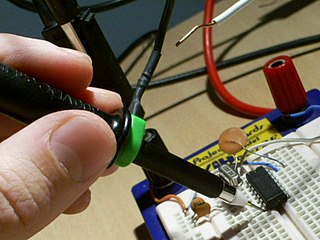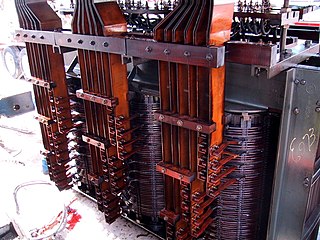
A Tesla coil is an electrical resonant transformer circuit designed by inventor Nikola Tesla in 1891. It is used to produce high-voltage, low-current, high-frequency alternating-current electricity. Tesla experimented with a number of different configurations consisting of two, or sometimes three, coupled resonant electric circuits.

The 555 timer IC is an integrated circuit used in a variety of timer, delay, pulse generation, and oscillator applications. It is one of the most popular timing ICs due to its flexibility and price. Derivatives provide two or four timing circuits in one package. The design was first marketed in 1972 by Signetics and used bipolar junction transistors. Since then, numerous companies have made the original timers and later similar low-power CMOS timers. In 2017, it was said that over a billion 555 timers are produced annually by some estimates, and that the design was "probably the most popular integrated circuit ever made".

Mark Levinson is an American high-end audio equipment brand established in 1972 by eponymous founder Mark Levinson, and based in Stamford, Connecticut. It is owned by Harman International Industries, a subsidiary of Samsung Electronics.

In electronics, a center tap (CT) is a contact made to a point halfway along a winding of a transformer or inductor, or along the element of a resistor or a potentiometer.
The Williamson amplifier is a four-stage, push-pull, Class A triode-output valve audio power amplifier designed by D. T. N. Williamson during World War II. The original circuit, published in 1947 and addressed to the worldwide do it yourself community, set the standard of high fidelity sound reproduction and served as a benchmark or reference amplifier design throughout the 1950s. The original circuit was copied by hundreds of thousands amateurs worldwide. It was an absolute favourite on the DIY scene of the 1950s, and in the beginning of the decade also dominated British and North American markets for factory-assembled amplifiers.
PS Audio is an American company specializing in high-fidelity audio components equipment for audiophiles and the sound recording industry. It currently produces audio amplifiers, preamplifiers, power related products, digital-to-analog converters, streaming audio, music management software and cables.

An Oudin coil, also called an Oudin oscillator or Oudin resonator, is a resonant transformer circuit that generates very high voltage, high frequency alternating current (AC) electricity at low current levels, used in the obsolete forms of electrotherapy around the turn of the 20th century. It is very similar to the Tesla coil, with the difference being that the Oudin coil was connected as an autotransformer. It was invented in 1893 by French physician Paul Marie Oudin as a modification of physician Jacques Arsene d'Arsonval's electrotherapy equipment and used in medical diathermy therapy as well as quack medicine until perhaps 1940. The high voltage output terminal of the coil was connected to an insulated handheld electrode which produced luminous brush discharges, which were applied to the patient's body to treat various medical conditions in electrotherapy.
The Mark Levinson No. 26S Dual Monaural Preamplifiers used Teflon circuit boards to supposedly differentiate the No. 26 and the 26S models, produced between 1991 and 1994 by Madrigal Audio Laboratories. This unit utilizes Camac coaxial connectors, which were used in the medical industry as well, because they break hot before they break ground when unplugged. No shorting electronics means a safe preamp and safe ER patients. An external power block, the PLS-226, was used to keep interference to a minimum.
Multiple electronic amplifiers can be connected such that they drive a single floating load (bridge) or a single common load (parallel), to increase the amount of power available in different situations. This is commonly encountered in audio applications.
In electronics, motorboating is a type of low frequency parasitic oscillation that sometimes occurs in audio and radio equipment and often manifests itself as a sound similar to an idling motorboat engine, a "put-put-put", in audio output from speakers or earphones. It is a problem encountered particularly in radio transceivers and older vacuum tube audio systems, guitar amplifiers, PA systems and is caused by some type of unwanted feedback in the circuit. The amplifying devices in audio and radio equipment are vulnerable to a variety of feedback problems, which can cause distinctive noise in the output. The term motorboating is applied to oscillations whose frequency is below the range of hearing, from 1 to 10 hertz, so the individual oscillations are heard as pulses. Sometimes the oscillations can even be seen visually as the woofer cones in speakers slowly moving in and out.

A test probe is a physical device used to connect electronic test equipment to a device under test (DUT). Test probes range from very simple, robust devices to complex probes that are sophisticated, expensive, and fragile. Specific types include test prods, oscilloscope probes and current probes. A test probe is often supplied as a test lead, which includes the probe, cable and terminating connector.
Optonica was a subdivision of Japanese electronics manufacturer Sharp that made high-end hi-fi products and systems.

Various types of electrical transformer are made for different purposes. Despite their design differences, the various types employ the same basic principle as discovered in 1831 by Michael Faraday, and share several key functional parts.
Technical specifications and detailed information on the valve audio amplifier, including its development history.

Constant-voltage speaker systems refer to networks of loudspeakers which are connected to an audio amplifier using step-up and step-down transformers to simplify impedance calculations and to minimize power loss over the speaker cables. They are more appropriately called high-voltage audio distribution systems. The voltage is constant only in the sense that at full power, the voltage in the system does not depend on the number of speakers driven. Constant-voltage speaker systems are also commonly referred to as 25-, 70-, 70.7-, 100 or 210-volt speaker systems; distributed speaker systems; or high-impedance speaker systems. In Canada and the US, they are most commonly referred to as 70-volt speakers. In Europe, the 100 V system is the most widespread, with amplifier and speaker products being simply labeled with 100 V.
Isolation amplifiers are a form of differential amplifier that allow measurement of small signals in the presence of a high common mode voltage by providing electrical isolation and an electrical safety barrier. They protect data acquisition components from common mode voltages, which are potential differences between instrument ground and signal ground. Instruments that are applied in the presence of a common mode voltage without an isolation barrier allow ground currents to circulate, leading in the best case to a noisy representation of the signal under investigation. In the worst case, assuming that the magnitude of common mode voltage or current is sufficient, instrument destruction is likely. Isolation amplifiers are used in medical instruments to ensure isolation of a patient from power supply leakage current.
Circlotron valve amplifier is a type of power amplifier utilizing symmetrical cathode-coupled bridge layout of the output stage. Original circlotrons of 1950s used output transformers to couple relatively high output impedance of vacuum tubes to low-impedance loudspeakers. Circlotron architecture, easily scalable, was eventually adapted to operate without output transformers, and present-day commercially produced circlotron models are of output transformerless (OTL) type.

A capacitive power supply or capacitive dropper is a type of power supply that uses the capacitive reactance of a capacitor to reduce higher AC mains voltage to a lower DC voltage.

The Pioneer SX-1980 is an AM/FM radio receiver that Pioneer Corporation introduced in 1978, to be matched with the HPM series of speakers. It was rated at 270 watts RMS per channel into 8 ohms, both channels driven. However, in the September 1978 issue of the magazine Audio, Leonard Feldman performed a specification test on the SX-1980 and stated in his report:
Though the new [IHF mandated] "Dynamic Headroom" measurement is specified in dB, it should be mentioned that based upon the short-term signal used to measure the 2.3 dB headroom of this amplifier, it was producing nearly 460 watts of short-term power under these test conditions!

The NE5532, also sold as SA5532, SE5532 and NG5532 is a dual monolithic, bipolar, internally compensated operational amplifier for audio applications introduced by Signetics in 1979. The 5532 and the contemporary TL072 were the first operational amplifiers that outperformed discrete class A circuits in professional audio applications. Due to low noise and very low distortion, the 5532 became the industry standard for professional audio. According to Douglas Self, "there is probably no music on the planet that has not passed through a hundred or more 5532s on its way to the consumer". The performance of the 5532 remained best in class for almost thirty years, until the introduction of the LM4562 in 2007. As of 2021, the 5532 remains in mass production as a generic product.











